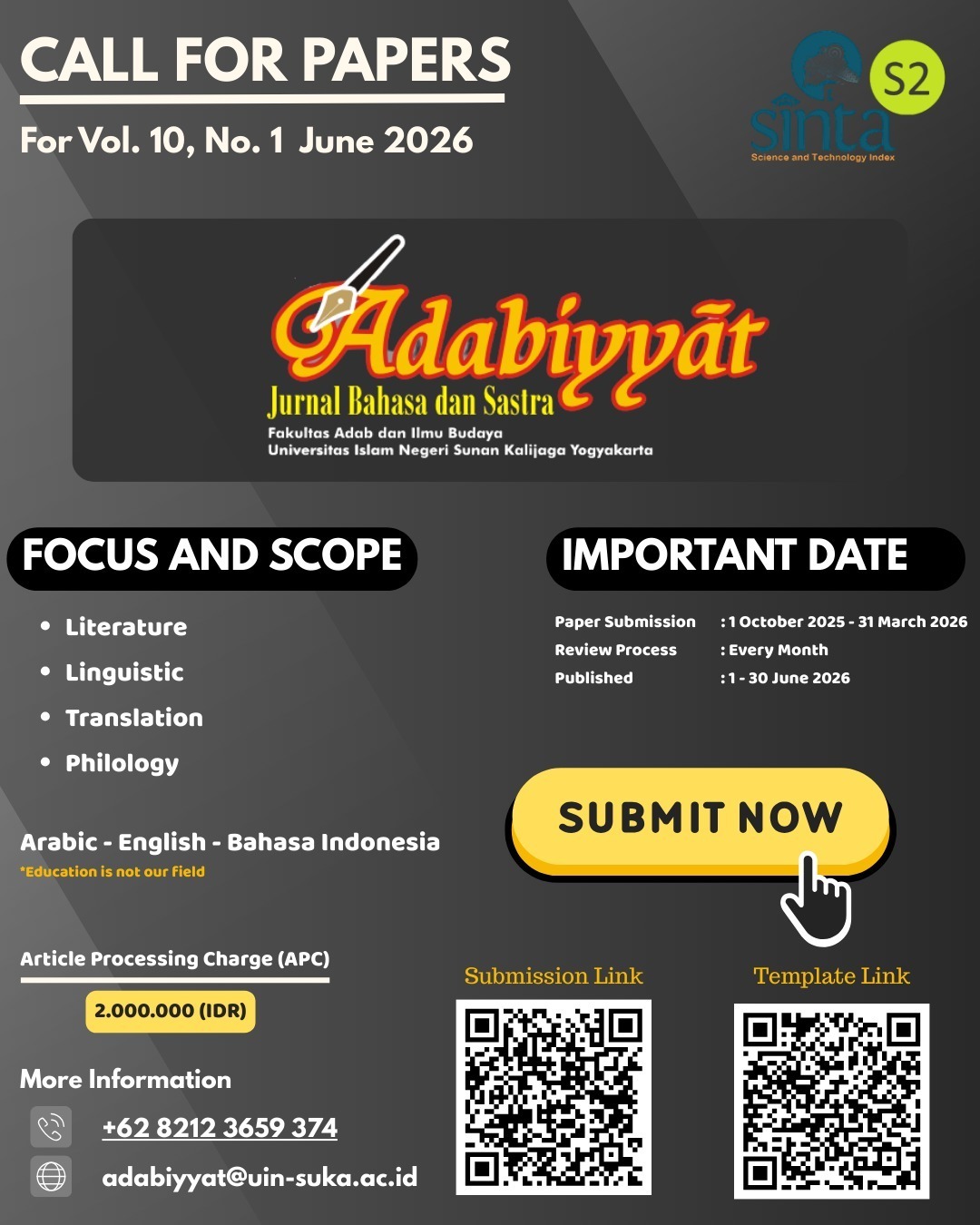KOMPLEKSITAS HUBUNGAN ANTARA WAZAN DAN MAKNA (Kajian terhadap Variasi Wazan dan Ambiguitas Bentuk Kata dalam Bahasa Arab)
DOI:
https://doi.org/10.14421/ajbs.2012.11101الملخص
This paper discusses wazans, including those relating to i'lal and ibdal, in Arabic and the efforts to make the learning easier for the sake of reading the language orthography with no harakat. Wazans in Arabic are hundreds, but this paper only focuses on those related to changes in the word forms (tasrif istilahi), whose wazans of fi’il ma alone are 35. The writer classifies examples of words with the same wazan, and combines wazan ruba'i mujarrad and mazid as well as the mulhaq, as both have the same syakal. He also maps the words of the same wazan but different meaning because the sigah (the word form) is different. As to facilitate the words that have ibdal andor i'lal, the writer gives examples of such words, to be the benchmark for the search of other examples. To conclude, first is that mastery of wazans in Arabic is very important not only to read the orthography without the syakal, but also to determine the meaning of the word. Second, although a wazan determines the meaning of a word, but there is problem since the same wazan may have different meanings. Third, the knowledge of the context of the utterance will help determine the meaning of the word, and the meaning finally defines the word wazan. In other words, wazan will be determined by the meaning of the word, and vice versa, wazan and context determine the meaning of the word. Fourth, the triangle of context, meaning and wazan relate to each other and have a very important role in the process of reading and understanding texts, but not necessarily the same wazan shows the same form of words, and vice versa. This is where the complexity is.
التنزيلات
المراجع
Ammar, Hamlāwi Ahmad bin Muhammad bin Ahmad al-. T.t. Syaza al-‘Urf fi Fann al-Ṣarf. Riyad: Dār al-Kayan.
Gulayaini, Mustafa. al-, 1984. Jāmi’ al-Durūs al-Arabiyyah, Bairut: al-Maktabah al-‘Aṣriyyah.
Hamd, Muhammad bin Ibrahim al-. 2005. Fiqh al-Lugah, Mafhūmuhu, Mauḍ’ātuhu wa Qaḍāyāhu. Riyad: Dār Khuzaimah.
Hamid, M. Muhyiddin ‘Abd al-. 1995. Durūs al-Tasrif, Bairut: al-Maktabah al-‘Aṣriyyah.
Hamid Hilāl, Abd al-Gaffār. 1986, Ilm al-Lugah bain al-Qadīm wa al-Hadīs. Kairo: al-Jablawi.
Hasyimi, al-Sayyid Ahmad al-, al-Qawā‘id al-Asāsiyyah li al-Lugah al-‘Arabiyyah, Bairut: Dār al-Kutub al-Ilmiyyah, t.t.
Lāsyīn, Mūsa Syāhīn. 2002. Al-La’ālu al-Hisān fī ‘Ulūm al-Qur’ān, Kairo: Dār asy-Syurūq.
Mahmud bin Isma’il. 2011. Taṣawwur Muqtarah Lita’lim al-Lugah al’-Arabiyyah li al-Nātiqin Bi Gairiha min al-Muslimin fi Ḍaou al-Turaṡ wa al-Ṣirā’ al-Lugawi, dalam: al-Nadwah al-Duwaliyyah Haula Tajribat Ta’lim al-Lugah al-‘Arabiyyah fi Indunisia, Malaha wa Ma‘alaiha, Malang: UIN maulana Malik Ibrahim.
Said, M. et.al. 2004. Al-Qāmus Inklizi - ‘Araby. Beirut: Dār al-Kutub al-Ilmiyyah.
التنزيلات
منشور
إصدار
القسم
الرخصة
- Adabiyyāt: Jurnal Bahasa dan Sastra publishes all articles entirely in full text.
- It is permissible for readers to download and to use it for scientific purposes and scientific dissemination.
- The author can re-publish the article that has been published by the Adabiyyāt: Jurnal Bahasa dan Sastra after obtaining written permission from the editor. This letter can be obtained by submitting a request letter for permission to republish the article to Adabiyyāt: Jurnal Bahasa dan Sastra via email adabiyyat@uin-suka.ac.id. In the second publication, the author is required to include information that the article was firstly published by the Adabiyyāt: Jurnal Bahasa dan Sastra.




















